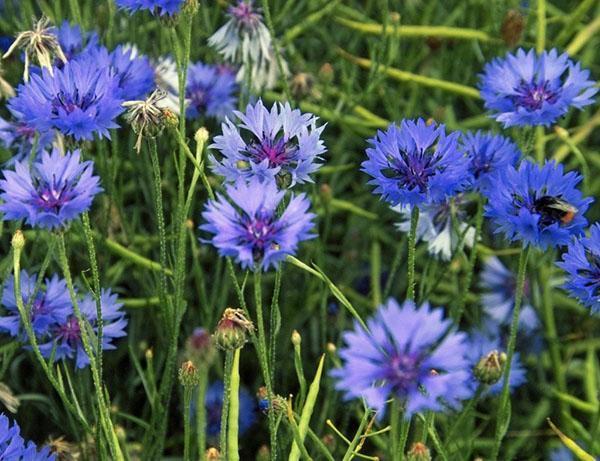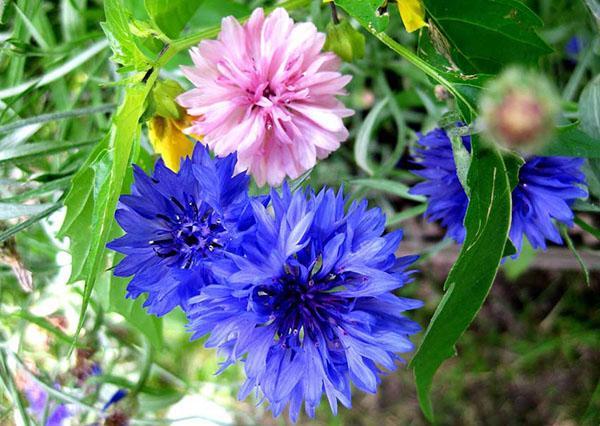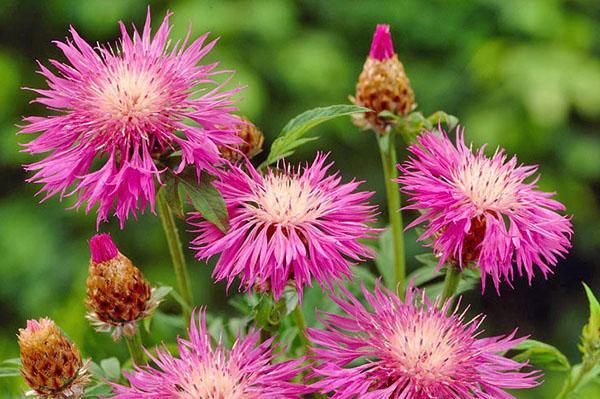Such a different and beautiful cornflower in a summer cottage
 It is worth remembering that. that all representatives of the Vasilkov family are plants up to 120 cm high, having a large, often branching rhizome. Cornflower can be used to obtain honey, as it is melliferous. The petals of some members of the family can be used as spices, and the flowers and plants themselves can be used as medicines in traditional medicine. In this article, photos are attached to the descriptions of each species.
It is worth remembering that. that all representatives of the Vasilkov family are plants up to 120 cm high, having a large, often branching rhizome. Cornflower can be used to obtain honey, as it is melliferous. The petals of some members of the family can be used as spices, and the flowers and plants themselves can be used as medicines in traditional medicine. In this article, photos are attached to the descriptions of each species.
What does cornflower look like

All plants of the cornflower family have a rather hard trunk, it is often rough, and sometimes its length reaches 120 centimeters. In cases where the trunk branches into the under-trunks, multiple inflorescences are possible, however, only one inflorescence can be on one sub-trunk.
 Flowers of the cornflower family can have different colors, especially if the species was bred through selection, but mainly the flowers of the cornflower family are painted in cold tones: from blue to deep purple.
Flowers of the cornflower family can have different colors, especially if the species was bred through selection, but mainly the flowers of the cornflower family are painted in cold tones: from blue to deep purple.
Cornflower meadow
 Cornflower meadow is a perennial plant, with a height of 30 centimeters to a meter, it is unpretentious and is found throughout Europe. The preferred climate is steppe.
Cornflower meadow is a perennial plant, with a height of 30 centimeters to a meter, it is unpretentious and is found throughout Europe. The preferred climate is steppe.
It has thin light purple petals, a hard, rough stem, at the end of which there is an inflorescence. The inflorescences are large, resembling the shape of an egg.
Medicinal properties:
- Choleretic, diuretic, anti-inflammatory and analgesic properties.
- The herb infusion on water is used in the treatment of hepatitis, dropsy, delayed menstruation, heart failure, gastalgia, migraines, and inflammatory processes of the urinary tract.
- Tincture of rhizomes is used for diarrhea.
- Boiled inflorescences are used to treat heart and uterine diseases.
- Tincture of flower pots for eczema, rheumatism, other diseases of the skin and joints.
- Baths with this flower have a beneficial effect on the cure of diathesis.
- The pounded seeds can be used to cure the human papillomavirus.
- Dried leaf powder is used to eliminate edema.
The flower is poorly understood in terms of its chemical composition and its effects on the body. The medical effect of the flower on children under 12 is undesirable. The aforementioned applications of cornflower in folk medicine are mainly theory, not supported by any scientific facts. In comparison with other species of the cornflower family, it is not as toxic, and can be safely used even for children over 12 years old.
Cornflower blue
 The blue cornflower is an annual or biennial plant that is often confused with a weed. Plant height - up to 60 centimeters. From the name it becomes clear that the flowers of this species are blue in color.
The blue cornflower is an annual or biennial plant that is often confused with a weed. Plant height - up to 60 centimeters. From the name it becomes clear that the flowers of this species are blue in color.
The plant has a thin, rough, straight trunk. The leaves are gray-green. Flowers are small, up to 3 centimeters in diameter. The flowers themselves in the inflorescence are arranged in 2 layers: bluer outside and darker, even purple inflorescences inside. Below is a photo of a representative of this kind of flowers.
Medicinal properties:
- The drugs are used as substances regulating electrolyte metabolism, diuretic, antipyretic, anti-inflammatory, antispasmodic, choleretic, laxative, analgesic, sedative, immunomodulatory, antibiotic.
- Flowers are used for urolithiasis, inflammatory processes of the urinary tract, for edema of the cardiovascular system and genitourinary system, tachycardia, diseases of the gastrointestinal tract and abdominal cavity, helminthic invasions, whooping cough, diseases of the upper respiratory tract, accumulation of uric acid in the joints, diarrhea ...
- Plant preparations improve appetite and have a beneficial effect on the gastrointestinal tract.
- External decoctions are used for eye pathology, mainly of an inflammatory nature, dermatitis.
- The crushed seeds are used to fight the human papillomavirus.
Solutions using blue cornflower can be dangerous due to the presence of a small amount of cyanic acids, therefore, the use of these drugs must be agreed with a doctor. The use of such drugs is undesirable for children under 12 years old.
Cornflower rough
 Cornflower rough - has a thick, straight trunk up to 120 centimeters high.
Cornflower rough - has a thick, straight trunk up to 120 centimeters high.
It is a perennial plant with a straight stem, which almost does not branch at the upper edge. Has dark green rough leaves. Flowers in inflorescences are in 2 layers: lighter purple on the outer layer, which do not bear seeds or honey, and darker inside, which are ovoid and are melliferous. Like many wild representatives of the cornflower family, they are similar to many plants that look like weeds
The herbal part of this plant is used for itching, hepatitis, dropsy, as an antiparasitic agent (against dwarf tapeworm and lamblia), with delayed menstruation, as a diuretic and choleretic, as an anti-inflammatory, wound-healing agent.
This plant is clearly poisonous, therefore, if possible, it is advisable to abandon treatment with it and use traditional medicine.
Cornflower mountain
 The mountain cornflower is a perennial plant that grows in mountainous areas. Outwardly, it looks like a blue cornflower. Blooms mainly from June to August. It has several subspecies.
The mountain cornflower is a perennial plant that grows in mountainous areas. Outwardly, it looks like a blue cornflower. Blooms mainly from June to August. It has several subspecies.
This plant has small (up to 85 mm in diameter) flowers. The plant is resistant to adverse conditions. Due to its unpretentiousness, it can grow on almost any soil without requiring special care.
Varieties:
- Alba is a short plant. The name (“white”) corresponds to the color of the flowers;

- Parham - purple

- Grandflora - has large blue flowers up to 80 mm in diameter;

- Rosea - according to the name it has pink flowers;

- Violeta - correspondingly dark purple flowers.

Uses of this plant species:
- For decorative purposes, for example, in rockeries, rock gardens.
- These flowers can stay in vases for a long time and not wither.
- The dried flowers can be used for winter bouquets.
Reproduction
 Similarly to other species of the cornflower family: either with the help of seeds, which are quite small in this plant (about 300 pcs per 1 g), or by dividing an adult flower. Like other representatives of the cornflower family, it is advisable to plant seeds within the first three years; after this time, the number of emerging plants decreases significantly. The flowering of plants sown with seeds begins the following year.
Similarly to other species of the cornflower family: either with the help of seeds, which are quite small in this plant (about 300 pcs per 1 g), or by dividing an adult flower. Like other representatives of the cornflower family, it is advisable to plant seeds within the first three years; after this time, the number of emerging plants decreases significantly. The flowering of plants sown with seeds begins the following year.
Planting and caring for the summer paint cornflower
 The summer paint cornflower is an artificially bred species that is used mainly for decorative purposes. In comparison with ordinary types, it can have not only standard, cool colors, but also brighter ones. In general, a plant of this species has one of the lowest heights among all representatives of the cornflower species.
The summer paint cornflower is an artificially bred species that is used mainly for decorative purposes. In comparison with ordinary types, it can have not only standard, cool colors, but also brighter ones. In general, a plant of this species has one of the lowest heights among all representatives of the cornflower species.
Read the instructions on the back of the seed package before planting your plants. Before planting, prepare all the necessary garden tools, improve the soil before sowing. Please note that the seeds are planted directly into the ground, without using seedlings. The distance between the seed holes should be at least half a meter to all adjacent holes.
One of the variants of reproduction takes place by dividing an adult plant into “divisions” and growing them directly.
Cornflower seeds are sown at the end of April, and division by dividing an adult plant occurs in mid to late August. Seeds will grow efficiently if they are less than three years old, otherwise the chance of successful germination is sharply reduced.
Plants are not whimsical, and they have enough glaze and loosening the soil for better oxygen access to the roots. Flowering when planted in April will come in June-July.